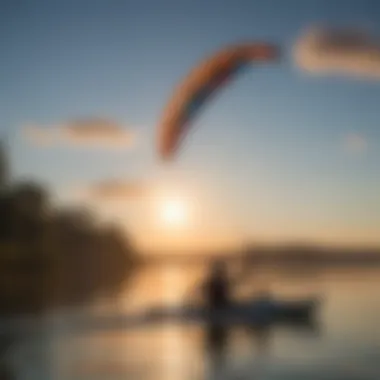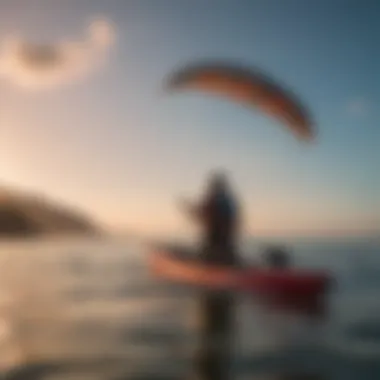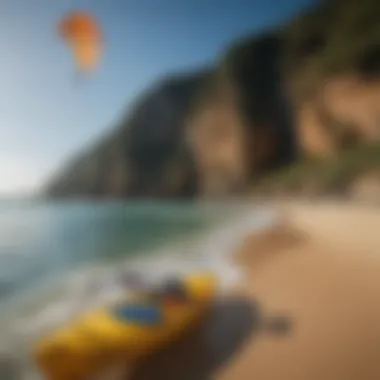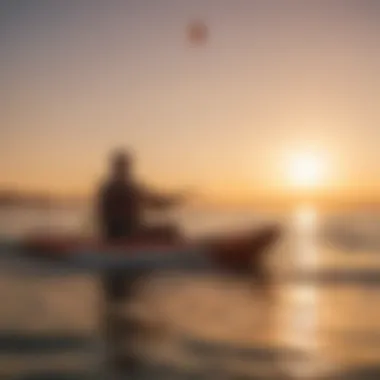Kayak Kite: Exploring the Fusion of Kayaking and Kitesurfing


Intro
Kayak kiting presents a unique blend of water sports, incorporating specific techniques and equipment that enrich the overall experience. This article aims to provide a comprehensive understanding, detailing the nuances associated with this thrilling sport. By focusing on equipment reviews, travel destinations, techniques, and safety guidelines, we aim to cater to both novices eager to learn and seasoned athletes seeking to enhance their skills.
Equipment Reviews
The essence of a successful kayak kite experience is not only in mastering techniques but also in having the right gear. The variety of equipment used can significantly affect performance and safety. This section will delve into essential equipment that every kayak kiter should consider.
Kites
The kite takes center stage in the kayak kiting setup. Different kite models offer varied features, shapes, and performance levels. It is essential to understand how these factors influence your ride.
Kite Shapes
Kites come in numerous shapes such as flat, delta, and bow. Each shape offers distinct advantages. Bow kites, for instance, are known for their versatility and ease of use, ideal for beginners.
Kite Sizes
Kite sizes, typically measured in square meters, range from 3 to 20 m². Understanding how size affects performance, such as atmospheric conditions and rider weight is key.
Materials
The materials used to construct kites have evolved. Modern kites utilize durable materials that enhance performance while reducing weight. Common materials include nylon and polyester.
Brands
When looking for quality kites, established brands like North Kiteboarding, Ozone, and Duotone are recommended. They offer a range of products catering to differing skill levels and preferences.
Boards
The board is as crucial as the kite itself, and different designs influence how one rides on the water.
Twintip vs.
Directional Boards
Twintip boards are symmetrical, allowing riding in both directions. This versatility is advantageous for beginners and freestyle riders. Directional boards, however, provide more control during wave riding but require a bit more skill.
Design and Construction
Modern boards are constructed using advanced materials like carbon fiber and wood cores. These elements contribute to lightweight designs without sacrificing durability and performance.
Accessories
In kayak kiting, accessories play a vital role in ensuring safety and enhancing the overall experience.
- Harnesses: Crucial for connecting the rider to the kite. There are seat and waist harnesses, each providing different levels of support.
- Lines: Strong lines ensure your kite remains steady and responsive.
- Pumps: Essential for inflating kites before use, ensuring you get on the water swiftly.
- Safety Gear: This includes impact vests and helmets, providing much-needed protection while riding.
Travel Destinations
Beyond the equipment, knowing the right locations to kayak kite is significant. Various canals, lakes, and coastal areas worldwide provide ideal conditions.
Popular Spots
Certain destinations are celebrated among the community for having optimal wind and water conditions. Spots like Hood River in Oregon, USA, and Cabarete in the Dominican Republic must be considered as they offer reliable winds and friendly locals.
Off the Beaten Path
There are unique locations away from the crowds that deliver unforgettable experiences. Consider places such as Varkala Beach in India or Mindarie in Australia, showcasing lesser-known wonders.
Techniques and Tutorials
Skills can vary greatly between individuals. Here, techniques intended for different experience levels will be explored, promoting skill development.
Beginner Guides
For those new to the sport, understanding basic techniques is crucial:
- Launching Your Kite: Focus on controlled ground launches.
- Riding: Begin with short distances, gradually building comfort and confidence.
- Turning: Practice smooth transitions to control your path.
- Landing: Master the landing techniques, ensuring a safe return to the beach.
Advanced Skills
As riders become proficient, mastering advanced maneuvers becomes the next goal. These skills include:
- Jumps: Learn proper timing and technique to launch:
- Tricks: Rotate on turns or perform aerial stunts.
- Freestyle Techniques: Play with the dynamics of kite kiting by exploring new moves.
Safety Guidelines


Participation in kayak kiting demands respect for safety. Understanding weather conditions and having emergency protocols in place is vital.
Weather Conditions
Knowledge regarding wind, tides, and local weather patterns aids in risk management. It's critical to regularly check wind forecasts before going out.
Emergency Protocols
Preparation is key. Familiarize yourself with emergency procedures and how to perform basic rescues:
- Assess the situation calmly to provide assistance effectively.
- Have communication devices on-hand for urgent calls if needed.
Equipment Maintenance
Regular checks of your equipment ensure longevity and safety. High-quality gear participates in preventing accidents.
Remember: Safety is foremost in all water sports. Regularly inspect and maintain equipment to guarantee preparedness for unexpected situations.
By understanding the guidelines, essential equipment, techniques, and the array of exciting destinations, kayak kiting becomes an adventure-rich sport that appeals to adventurers worldwide.
Prelims to Kayak Kite
The combination of kayaking and kitesurfing has given birth to a unique water sport that captures the interest of many enthusiasts: the kayak kite. This hybrid sport merges the thrill of gliding over water in a kayak with the exhilarating pull of a kite, creating a dynamic experience that appeals to both adrenaline seekers and nature lovers. In this article, we explore various aspects of kayak kiting, including its equipment, techniques, safety measures, and best practices.
Definition of Kayak Kite
The term kayak kite refers to the practice of using a water kayak along with a traction kite. The kite is designed to generate forward force and assist the paddler, allowing for faster movement across the water. This activity doesn’t replace traditional kayaking but enhances it with aspects of kitesurfing. Kayak kite enthusiasts harness wind power, bringing a new dimension to their outdoor adventure. Moreover, it allows paddlers to traverse longer distances while also enabling the thrill of gliding.
Historical Context
Kayak kiting has its roots in both kayaking and kitesurfing, which have been popular for decades. Traditional kayaking emerged as a means of transportation for various cultures for hundreds of years, while kitesurfing became widely popular in the late 20th century. The blending of these two activities began in the early 2000s, when innovative water sports enthusiasts sought new ways to engage with their surroundings. By tethering kites to kayaks, they created a means of exploring larger bodies of water while incorporating the fun of kites. This historical crossover highlights an enduring innovation driven by expanding passions for adventure.
Growth in Popularity
In recent years, kayak kiting has experienced a notable increase in popularity. This rise can be attributed to several factors:
- Access to Waterways: Increased access to lakes, rivers, and coastal areas has made it easier for enthusiasts to experiment with this unique sport.
- Thriving Communities: Local clubs and online forums have contributed to sharing knowledge, tips, and experiences, bridging gaps among kayakers and kite enthusiasts.
- Wider Reach of Adventures: The sport accommodates a variety of skill levels, making it accessible for people who may want to combine some skills between both watersport disciplines.
The community's energy continues to inspire newcomers and veterans alike, solidifying kayak kiting's place in water sports culture.
Kayak kiting is not just a flexible sport; it's a creative platform for those looking for connection with nature and exhilarating experiences.
Equipment Essentials
Understanding the critical elements of equipment essentials is vital in kayak kiting. This section covers the functional aspects of the sport, ensuring a safe, enjoyable, and effective experience. Selecting the right equipment directly influences performance, maneuverability, and safety, which is paramount for enthusiasts at any skill level. By properly analyzing gear requirements, one empowers themselves to engage more confidently in this hybrid water sport.
Types of Kites
The type of kite used plays a crucial role in the experiences of kayak kiting. Various designs are available, catering to different wind conditions, skill levels, and personal preferences. Here are some common types:
- Leisure Kites: These kites are typically easy to fly and suitable for beginners, focusing on general enjoyment rather than technical performance.
- Performance Kites: Generally used by experienced kitesurfers, these kites allow for extreme maneuvers and higher jumps. They often have specialized features designed for aerial tricks.
- Foil Kites: These kites have an open-cell design that captures wind, allowing for high lift. They are generally lightweight and perform well in varying conditions.
- Inflatable Kites: These kites come with bladders that maintain their shape in the air. They are durable and versatile but usually heavier, impacting responsiveness.
When choosing a kite for kayaking, consider the expected wind conditions at your desired location and your skill level in terms of handling various kite designs.
Kayak Selection
The selection of the kayak is another significant factor in kayak kiting. The ideal kayak should match both your planned activities and the specific kiting style you want to pursue. Below are essential considerations for kayak selection:
- Type of Kayak: There are three main types—sit-on-top, traditional touring, and inflatable kayaks. Each has unique advantages. Sit-on-top kayaks offer easier entry and exit and are commonly used for ease in kiting. Touring kayaks provide better stability for certain techniques.
- Size and Weight: A kayak that too heavy can hinder maneuverability while a kayak that’s too narrow may compromise stability. Choose a kayak that your strength level can comfortably manage.
- Material: Common materials for kayaks include plastic, fiberglass, and composite. Each of these materials offer different levels of durability,r and performance. Plastic models are often the most durable, while fiberglass kayaks usually provide better performance but can be more fragile.
In summary, selecting the right kayak is paramount. It ensures confidence in sailing swiftly through water, specifically noon or mid-range winds.
Safety Gear
Oftentimes, enthusiasts focus on performance equipment but overlook critical safety gear. Safety gear enhances not only protection but mental confidence during outdoor activities. Key safety items include:
- Personal Flotation Device (PFD): Always wear a buoyancy aid. It keeps you afloat in the event of capsizing or falling.
- Helmet: Protects a user’s head, particularly during hard landings.
- Harness: If utilizing a performance kite, it’s crucial to have a suitable harness and complete safety setup to increase comfort and control over flying a kite.
- Navigation Tools: For longer trips, having a compass or navigational technology can help mitigate risks of getting lost.
- First Aid Kit: Keep essentials handy. This preparation may be crucial in uncomfortable or emergency situations.
Ultimately, selecting proper safety gear is indispensable for facilitating a favorable kayaking community by safeguarding against potential hazards.
Lastly, always remember that appropriate equipment greatly enhances the kayaking experience, making it not only safer but also more enjoyable.
Techniques for Kayak Kiting
The section on techniques for kayak kiting reveals critical aspects of the sport. Mastering the right approaches and methods enhances both safety and enjoyment. These techniques are no less than crucial; they influence the overall experience and provide a solid foundation for new and advanced practitioners alike.
Getting Started


To begin with kayak kiting, some essential techniques must be adopted.
First and foremost, familiarity with your equipment is paramount. Such knowledge not only includes how to setup your kite but also understanding how it interacts with water and wind conditions. Practicing in controlled environments helps beginners build confidence without unexpected challenges.
Next step involves learning how to launch the kite. Stand in shallow water for a smooth transition while holding the kite steady against the wind. A proper launch reduces risk of mishaps. As you become comfortable, practice directing the kite using your paddle, which is key to manoeuvring.
Don't forget to develop your paddling technique. Coordinated movements between paddling and kite management lead to effective travel paths on water. Focus on balance and posture; staying centered in the kayak ensures optimal control.
Another important point is to start learning in mild wind conditions. Strong winds can make steering difficult and put you at higher risk. As you gain confidence, experiment with stronger winds gradually.
Advanced Maneuvers
Once comfortably situated in the basics, moving into advanced maneuvers is an exhilarating territory. Practitioners might explore more intricate movement, such as jumps and turns. Each maneuver has its own preparation phase, which consists of timing and coordination of your board movements along with kite control.
Jumping is an exciting skill to perfect. Approaching a specific speed, pull on the kite back while positioning your paddle in the right angle will send you airborne. Remember to master landing techniques for smooth and safe descents. This process requires a nuanced understanding of forces at play.
Another advanced technique involves kiteloops, which require impressive kite skills and timing. This maneuver can boost speed and intensity exponentially. Understanding the flight angle of your kite becomes a necessity here; the actions should mirror foreseen outcomes to ensure control while airborne.
Successful execution of such advanced maneuvers opens vast opportunities for further skills and can connect you to an experienced community, encouraging a solid growth trajectory.
Wind Conditions and Navigation
The success of your kayak kiting depends heavily on the ability to respond to wind conditions. Understanding how to read these conditions dramatically influence the choices you make on the water. For instance, constant monitoring allows for better navigation and decision-making.
Categorizing wind patterns should be a priority. Always identify the consolidated sources of wind in your surroundings before going out. These could include hugs of trees or obstructions that create wind shadows. When riding in strong winds, be cautious and decisive with your movements to avoid unnecessary risks.
Weather systems also merit close scrutiny so they can be understood. Comprehending patterns ensures that one is prepared for changing conditions. Before each outing, check forecasts from reliable weather sites.
Additionally, learn how the contours of the water affect your predictable movements. Waves and currents can be the fresh factors complicating maneuvers. Familiarizing yourself with local water routes improves both navigation skills and amplification of overall fun.
Understanding wind and water patterns does not only heighten your experience. It might prove to be essential for your safety in navigating accidental hazards.
Safety Considerations
The significance of safety considerations in kayak kiting cannot be overstated. Engaging in any water sport, especially one combining kayaking and kitesurfing, entails inherent risks. Proper awareness and preparation can greatly enhance the enjoyment of the activity while minimizing accidents. It is essential to familiarize oneself with safety guidelines, understand potential risks, and implement effective preventive measures.
Understanding Risks
Kayak kiting presents a unique set of challenges. One primary risk involves changing wind conditions. Unpredictable gusts can lead to sudden crashes, further exacerbated by the compact space of a kayak. The risk of capsizing also heightens, particularly when combined with the dynamics of a kite. Moreover, underwater hazards such as rocks, shallow areas, or tilted water surfaces may pose dangers both to individuals and their equipment.
Drowning is, of course, a serious concern, which elevates the necessity for suitable life vests. Additionally, injuries as a result of mismanagement of the kite can occur, either from low-speed collision of the kayak or if the kite lines become tangled. Thus, awareness of the environment and the condition of your gear before adventuring out is undeniably crucial.
Accident Prevention Strategies
Preventing accidents requires a multi-faceted approach. Adopting best practices in equipment management and situational awareness is imperative. Here are basic strategies:
- Wear Appropriate Safety Gear: Always don a personal flotation device. Additionally, helmets can protect against injury in rough conditions.
- Check the Weather Forecast: Know the intensity and direction of wind before heading out. Sudden changes can happen, and understanding forecasts lowers risk significantly.
- Train Before You Go: Continuous education about kayak kiting properly enhances maneuvering skills, ensuring better control over both the kayak and the kite. Attendance at clinics or community classes is highly sensible.
- Buddy System: Pairing with another paddler can provide invaluable help during distress or emergency.
By incorporating these strategies, participants will significantly lessen the likelihood of accidents amid their endeavors.
Emergency Protocols
Understanding steps required in case of an emergency can be a difference between safe extraction and peril.
- Assess the Situation: Your first action should be to examine the environment following an accident. Could more help be necessary?
- Signal for Help: Whether through sound signals or visual signals like emergency flares, being noticed is essential.
- Evacuate if Necessary: If unable to control the kayak, bracing for impact while planning exit routes can ensure survival until help arrives.
- Utilize Whistle Communication: Whistles serve well as a compact communication tool. Using sharp, short bursts enable rescuers to locate you if separation occurs.
Always prepare for emergencies with a well-thought-out plan and awareness of local rescue resources.
Writing these measures down may also help prepare your thoughts in tense moments. Knowing the proper steps can ultimately lead to a more comfortable outing. Adopting a proactive safety mindset certainly allows kayak kiting to remain enjoyable while minimizing the risks involved in this thrilling water sport.
Destinations for Kayak Kiting
The appeal of kayak kiting extends beyond technique and equipment; it encompasses the mere act of being present in the right environment. Identifying suitable destinations plays a critical role in ensuring a rewarding experience. Locations not only provide the physical space needed to practice the skill but also encapsulate the aesthetic and recreational traits associated with the sport.
Particular attentiveness to both natural and developed environments can enhance the kayak kiting journey. Factors like wind patterns, water conditions, scenery, and available amenities influence a destination’s rating. Knowing these will vastly improve the placements of novices and seasoned practitioners as they set out on adventures.
Furthermore, being in a community that understands the ethos of kayak kiting fosters more than skill development. It strengthens a sense of belonging to this unique sporting culture.
Top Global Locations
When one thinks of prime spots for kayak kiting, a few standout destinations come to mind.
- Hood River, Oregon: Renowned for consistent wind and a picturesque backdrop, this location offers both calm waters and challenging maneuvers. The Columbia River Gorge allows kitesurfers opportunities to venture beyond the shoreline.
- Tarifa, Spain: Known as the ‘kiting capital’, Tarifa boasts unyielding winds almost year-round. The unique geography of the Mediterranean areas provides a demographic where aquatic sports flourish.
- North Sea, Netherlands: Conditions here invite thrill-seekers from around the globe. The expansive beaches and reliable winds make for tempting profiles for emerging adventures.
While visiting these locales, understanding wind statistics, times of year, and additional offerings can optimize the experience. Adequate research on these aspects contributes significantly to satisfying adventures.
Local Hidden Gems


Beyond famous destinations lies a network of lesser-known spots that can prove invaluable to those looking for a quieter but satisfying experience.
- Pine Island, Florida: This serene island features tranquil waters, perfect for those looking to improve their skills undisturbed.
- Desolation Sound, Canada: While lesser acknowledged, it provides a remarkable backdrop with a unique blend of wildlife. Navigation becomes just as exciting as the ride itself.
- Lake Superior, Michigan: Ideal for skilled enthusiasts to embrace unique climatic challenges while soaking in scenery blurred between sky and liquid landscape.
Exploring these hidden gems opens opportunities for solitude and personal mastery, often found in over-crowded tourist spots.
Seasonal Considerations
Each season bears distinct characteristics important to consideration for kayak kiting. These also aid in planning adventures.
- Spring: Offers milder weather, establishing the perfect conditions for beginners or individuals tending to perfect their craft.
- Summer: Allows for family-based outings while providing optimal kiting wind conditions. Relationships develop over shared experiences during sunny days.
- Autumn: Displays stunning backdrops as foliage changes. Less crowded beaches create a magical environment in which enthusiasts can thrive.
- Winter: Throughout regions characterized by country-wide wind swells, this season involves unique challenges. Extreme enthusiasts can capitalize on these rainy beauties.
Recognizing how each season influences water sports makes a noticeable difference for participants. Proactive pre-travel investigation can centralize visits during peak times while still providing comfort in service availability.
By understanding the nuances involved in choosing the right destinations, participants can make informed decisions to enrich their kayak kiting experiences emphasizing safety, community, and exploration.
The Community and Lifestyle
The community surrounding kayak kiting is vital to its continued growth and appreciation. This lifestyle is not merely about the activity itself, but also the shared passion it generates among enthusiasts. Engaging with like-minded people operates as a catalyst for skill development and safety knowledge sharing.
Joining Local Clubs
Local clubs play an important role in nurturing the kayak kite community. They represent a space for collaboration and camaraderie, allowing individuals to share experiences and learn from each other. Members often organize group outings, where beginners can gain confidence through collective support. The shared experiences from these outings build long-lasting friendships and a sincere sense of belonging.
A typical local club focuses on:
- Group learning sessions for both novices and seasoned kiters.
- Safety workshops to enhance awareness and responsibility on the water.
- Local environmental initiatives to promote sustainable kayaking and kiting.
Online Forums and Resources
In the digital age, online resources have become an integral part of the kayak kiting community. Forums such as Reddit and Facebook groups offer platforms for information exchange. Members can seek advice, share tips and discuss new gear. Online discussions facilitate connections across global lines, widening the community's scope.
Key elements include:
- Frequently asked questions sections where common queries go answered.
- Gear reviews to assist with informed decision-making on equipment.
- Community challenges to engage and motivate enthusiasts.
Events and Competitions
Events and competitions are essential to the kayak kite culture. These gatherings showcase skills, promote friendly competition, and help set standards within the community. Participants often walk away with valuable feedback that sharpens their abilities and inspires individuals to push their limits.
Participating in such events offers multiple benefits, such as:
- Earning recognition within the community for achievements.
- Opportunity to learn from experienced professionals by observing techniques.
- Networking with vendors who can provide access to the latest equipment.
Events encourage not only skill growth but also the formation of relationships with fellow enthusiasts, promoting a more integrated community.
All aspects of community and lifestyle in kayak kiting hold significance beyond the sport. It collectively energizes efforts toward sustainability, enhances individual growth, and encapsulates the thrill of adventurous spirit shared by all members.
Environmental Considerations
The relationship between sports, especially those involving nature, can be intricate. Kayak kiting, as a unique blending of kayaking and kitesurfing, highlights this complexity, making it essential to discuss environmental considerations. Addressing this topic fosters a better understanding of how activities impact our surroundings and encourages responsible participation in outdoor sports.
Impact on Natural Habitats
Kayak kiting can have dual aspects regarding natural environments. On one hand, it allows enthusiasts to appreciate natural beauty from the water while getting closer to nature. On the other hand, it poses threats to the ecosystems inhabiting coastal and aquatic regions.
- Disturbance of Wildlife: When paddlers and kiters venture into wildlife habitats, the presence can stress and displace vulnerable species.
- Physical Impact: Anchoring kayaks can damage underwater flora, disrupting a fragile balance. Proper education about avoiding sensitive areas is critical for this element.
- Pollution Risk: Disposing of equipment, excess plastics, and other waste threatens the quality of our waters.
Ultimately, participants have the power to minimize these impacts by understanding their environment and engaging in responsible practices. As such, awareness of the effects of kayak kiting on habitats should guide all activities.
Sustainable Practices
Sustainability in kayak kiting involves integrating practices that reduce the sport's footprint while cherishing the outdoors. Saving the environments gives a chance to continue enjoying these amazing experiences. Several strategies can enhance sustainability in this sport:
- Education: Being informed on local ecosystems. Participating in workshops or online courses can offer insights about protecting marine life while maximizing enjoyment.
- Leave No Trace: Adhere to principles that emphasize respecting nature—for instance, picking up trash, never disturbing wildlife, and maintaining distance from nesting sites.
- Eco-Friendly Gear: Choose kites and kayaks made from sustainable or recyclable materials. This not only minimizes the overall impact but also supports companies following the same principles.
Epilogue
The topic of kayaking and kitesurfing integration, often called kayak kiting, is of significant relevance within the broader context of water sports. Kayak kite combines elements of both sports, presenting unique geological benefits. This intricate synthesis showcases how technology has expanded recreational endeavors while pushing the limits of traditional water activities. As enthusiasts, understanding the implications of this niche caters to growth leads towards optimizing overall enjoyment and safety.
The Future of Kayak Kite
Looking ahead, the future of kayak kite represents a promising avenue. With advancements in kite design and materials, stability and functionality are improving. This evolution not only enhances performance but also widens the demographic appeal, interesting those who may be intimidated by more specialized sports. A few anticipated developments include:
- More Lightweight Gear: Materials such as carbon fiber are making equipment less cumbersome.
- Increased Skill Development Programs: More groups may establish training schemes focusing on novices, possibly alleviating the skills gap.
- Tech Integration: The emergence of smart devices may offer kiting enthusiasts modulated performance insights.
The backdrop of global environmental movements may shape the platforms through which kayak kiting is promoted. Sustainable kayaking and eco-conscious participation initiatives could become more prevalent, driving a strong connection between participants and the natural landscapes they traverse.
Final Thoughts
In summary, kayak kiting embodies a growing blend of enthusiasm innovation in the realm of outdoor leisure. It harmonizes the techniques of paddling with the thrilling elements of kitesurfing, appealing to a wide range of outdoor adventurers. Participation involves significant risks; therefore, cultivating a strong commitment to safety practices is cardinal. That is vital as beginners enter the space ripe with excitement but also uncertainty. Educating oneself on equipment, local regulations in tackyards, and connecting with responsive communities enhances your exploration.
Reflecting on all aspects mentioned, those who choose to engage in kayak kiting generally report refining their dexterities while forging connections with a community rooted in passion for the sport. Undoubtedly, the realm of kayak and kiting offers a unique harmony of physical stimulation and adventure, making it a fascinating field of focus for decades to come.
Kayak kite emerges at a junction where skill meets nature; commitment unlocks pathways to profound experiences.







